刘润清外语教学中的科研方法共27页
国内外外语教学法著作
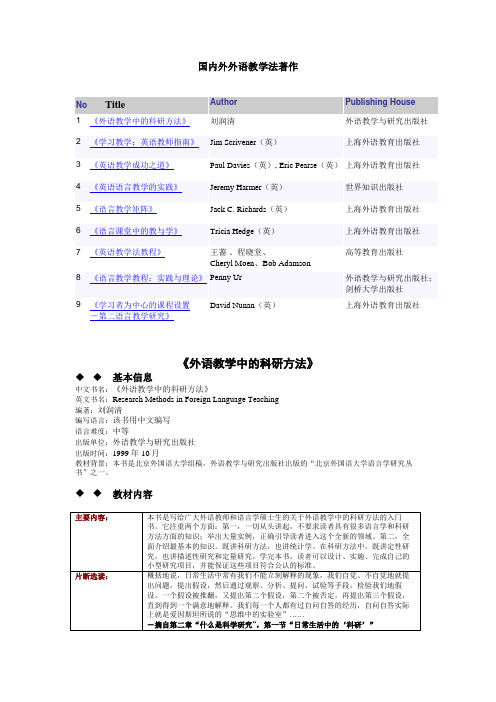
国内外外语教学法著作No Title Author Publishing House1《外语教学中的科研方法》刘润清外语教学与研究出版社3《英语教学成功之道》Paul Davies(英), Eric Pearse(英)上海外语教育出版社5《语言教学矩阵》Jack C. Richards(英)上海外语教育出版社7《英语教学法教程》王蔷、程晓堂、高等教育出版社Cheryl Moen、Bob Adamson9《学习者为中心的课程设置David Nunan(英)上海外语教育出版社-第二语言教学研究》《外语教学中的科研方法》◆◆基本信息中文书名:《外语教学中的科研方法》英文书名:Research Methods in Foreign Language Teaching编著:刘润清编写语言:该书用中文编写语言难度:中等出版单位:外语教学与研究出版社出版时间:1999年10月教材背景:本书是北京外国语大学组稿,外语教学与研究出版社出版的“北京外国语大学语言学研究丛书”之一。
◆◆教材内容外语教学中的科研方法第一章第一章引言:为什么要讲外语教学科研方法第二章第二章什么是科学研究第一节第一节日常生活中的“科研”第二节第二节科研与常识的关系第三节第三节何时得出结论第四节第四节研究的分类第三章第三章外语教学科研的模式第一节第一节理论模式的作用第二节第二节综合法和分析法第三节第三节归纳法和演绎法第四节第四节对研究环境的控制第五节第五节数据的性质和数据的收集第四章第四章定性方法和定量方法第一节第一节定性方法第二节第二节定量方法第三节第三节定性方法和定量方法的比较第四节第四节两种方法之间的连续体第五章第五章起草科研申请报告第一节第一节选定研究课题第二节第二节文献综述第三节第三节科研方法第四节第四节报告的其他部分第五节第五节科研申请报告的评估第六章第六章定性研究:设计与调查手段第一节第一节定性研究的设计第二节第二节观察第三节第三节访谈第四节第四节笔记和日记第五节第五节录音和录像第六节第六节口头自陈第七节第七节文卷第八节第八节数据分析第九节第九节实例介绍第七章第七章描述性研究第一节第一节引言第二节第二节个案研究第三节第三节小组研究第四节第四节勘查法第五节第五节发展研究法第八章第八章相关关系研究第一节第一节基本概念第二节第二节基本特征第三节第三节相关系数的解释第四节第四节研究实例分析第九章第九章追溯性研究第一节第一节引言第二节第二节两种追溯性研究第三节第三节追溯性研究的特点第四节第四节优点和缺点第五节第五节如何使用第六节第六节设计第七节第七节如何提高追溯研究的信度第八节第八节实例介绍第十章第十章实验研究第一节第一节引言第二节第二节前试验研究第三节第三节真正的实验设计第四节第四节因子设计第五节第五节准实验设计第六节第六节变量第七节第七节影响内部效度的因素第八节第八节影响外部效度的因素第九节第九节实验研究实例介绍《学习教学:英语教师指南》◆◆基本信息中文书名:《学习教学:英语教师指南》英文书名:Learning Teaching- A Guidebook for English Language Teaching编著:Jim Scrivener(英)编写语言:该书全部用英文编写语言难度:中等出版单位:上海外语教育出版社出版时间:2002年11月教材背景:本书是上海外语教育出版社从麦克米伦出版社引进出版的外语教学法丛书之一。
外语教学中的科研方法(共2篇)

外语教学中的科研方法(共2篇)以下是网友分享的关于外语教学中的科研方法的资料2篇,希望对您有所帮助,就爱阅读感谢您的支持。
篇1任务型教学在初中英语教学中实施情况的调查研究摘要:虽然任务型教学的倡导者们在进行大量的研究和实践的基础上,取得了许多可喜的发现和成果,但我们应清醒地看到在初中英语教学过程中仍然存在着一些不容忽视的问题。
要正确和全面地领会新课标的精神和理念,更好地研究和实施任务型教学,使任务型教学在英语课堂上发挥最大的作用,开展关于英语教师对任务型教学实施情况的调查研究,了解教师对它的认可度和实施效果,分析任务型英语教学中的困惑和问题是十分必要的,并针对所存在的问题提出一些建议和意见,为实际的英语教学提供一些启示。
关键词:任务;任务型教学;初中英语;问题一、文献综述任务型教学法是20世纪80年代兴起的一种强调“用语言做事”的语言教学方法。
Prabhu 是英籍印度语言学家,作为强交际观的倡导者,他在印度南部Bangalore 进行了一项强交际法的实验(Bangalore Project)。
1982年他发表了班加罗尔实验报告,并于1983年提出了任务型教学法(魏永红,2004),其目的是使学生通过运用语言完成任务的方式来学习语言。
在任务的划分分上,Prabhu 把学习任务分为三大类。
:信息差活动, 推理差活动, 意见差活动。
在具体的教学上,他把任务型模式分为三个阶段:前任务、任务和反馈。
纽南(Nunan,1989)提出了交际课堂的任务设计模式。
在他看来,分析交际任务的模式应该包括:目标、输入、活动、教师角色、学习者角色和情景。
威莉斯(Willis ,1996)在《任务型学习模式》一书中提出了组织任务的三阶段模式:前任务,任务环和语言聚焦。
随后,人们提出了互动假设(Long,1996) 、交际效度理论(Yule.1997) 、从认知角度来看任务型教学(Skehan,1998) 、任务型教学的认知和社会维度分析(Ellis,D .,2000) 、任务型教学的方法论与社会文化观(Nunan 2001)。
外语教学中的实验研究法

外语教学中的实验研究法作者:沈美序来源:《北方文学》2018年第15期摘要:实验研究法是教育科研方法中的重要组成部分,意在通过操控自变量来观察被试对象所发生的变化,从而对最初的假设进行验证。
本文通过对外语教学环境中的实验研究法进行介绍与举例分析,以期为相关研究者与师生的教学与实验研究提供参考与反思。
关键词:外语教学;实验研究;实验研究法一、外语教学中实验研究法的概念对于实验研究法,朗文语言学词典中给出的定义如下:教育研究的一种方法,通过设立一个能鉴定出不同试验对象或变量之间关系的情境,来检验或证实一个观点或假设。
刘润清(2015)称其为设计一个能反映研究对象本质特征的情境,并使研究对象不受实验变量以外的因素所干扰,然后对其实施处理,以观察它的某种变化,从而检验实验处理与该种特性之间的因果关系假设。
由此可知,实验研究法是出于某种已设定好的假设与目的,选取实验对象,控制无关的干扰因素,接着操纵自变量来观察获测量因变量的变化的一种教育科研方法。
而外语教学中的实验研究法则将研究范围设定于与外语教学有关的一系列变量,例如研究外语语言水平(包括听、说、读、写等方面)、教材、学习动机等,以及作为个体差异的变量,包括性别、认知方式、学习策略等。
二、外语教学中实验研究法的主要类型根据实施实验的实施环境条件,实验研究法可分为实验室实验或自然实验。
实验室实验即为在实验条件严格控制下,借助专门的实验设备,在实验室里控制影响学生外语能力水平的条件,以观测学生在外语能力上的变化。
自然实验就是在现实的教育情境中进行的实验,这种实验突出了实验的自然性,即让被试处于日常活动的环境中,尽量不让被试受到实验的干扰,以便获得被试日常的真实表现。
现今学术论文中的绝大部分外语教学中的实验研究法均为自然实验——在学校的班级中进行研究对象的挑选和實验的实施。
根据实验中无关变量控制程度或实验被试分配的随机化程度,教育实验可分为前实验、准实验和真实验,这也是现今最为公认的实验研究法的分类。
华中师范大学外国语言学及应用语言学专业(硕士)课程简介
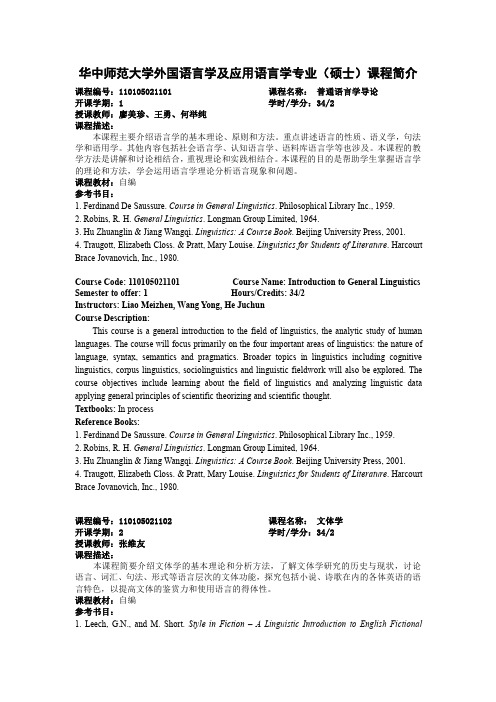
华中师范大学外国语言学及应用语言学专业(硕士)课程简介课程编号:110105021101课程名称:普通语言学导论开课学期:1学时/学分:34/2授课教师:廖美珍、王勇、何举纯课程描述:本课程主要介绍语言学的基本理论、原则和方法。
重点讲述语言的性质、语义学,句法学和语用学。
其他内容包括社会语言学、认知语言学、语料库语言学等也涉及。
本课程的教学方法是讲解和讨论相结合,重视理论和实践相结合。
本课程的目的是帮助学生掌握语言学的理论和方法,学会运用语言学理论分析语言现象和问题。
课程教材:自编参考书目:1.Ferdinand De Saussure.Course in General Linguistics.Philosophical Library Inc.,1959.2.Robins,R.H.General Linguistics.Longman Group Limited,1964.3.Hu Zhuanglin&Jiang Wangqi.Linguistics:A Course Book.Beijing University Press,2001.4.Traugott,Elizabeth Closs.&Pratt,Mary Louise.Linguistics for Students of Literature.Harcourt Brace Jovanovich,Inc.,1980.Course Code:110105021101Course Name:Introduction to General Linguistics Semester to offer:1Hours/Credits:34/2Instructors:Liao Meizhen,Wang Yong,He JuchunCourse Description:This course is a general introduction to the field of linguistics,the analytic study of human languages.The course will focus primarily on the four important areas of linguistics:the nature of language,syntax,semantics and pragmatics.Broader topics in linguistics including cognitive linguistics,corpus linguistics,sociolinguistics and linguistic fieldwork will also be explored.The course objectives include learning about the field of linguistics and analyzing linguistic data applying general principles of scientific theorizing and scientific thought.Textbooks:In processReference Books:1.Ferdinand De Saussure.Course in General Linguistics.Philosophical Library Inc.,1959.2.Robins,R.H.General Linguistics.Longman Group Limited,1964.3.Hu Zhuanglin&Jiang Wangqi.Linguistics:A Course Book.Beijing University Press,2001.4.Traugott,Elizabeth Closs.&Pratt,Mary Louise.Linguistics for Students of Literature.Harcourt Brace Jovanovich,Inc.,1980.课程编号:110105021102课程名称:文体学开课学期:2学时/学分:34/2授课教师:张维友课程描述:本课程简要介绍文体学的基本理论和分析方法,了解文体学研究的历史与现状,讨论语言、词汇、句法、形式等语言层次的文体功能,探究包括小说、诗歌在内的各体英语的语言特色,以提高文体的鉴赏力和使用语言的得体性。
国语大学刘润清教授谈英语的教与学
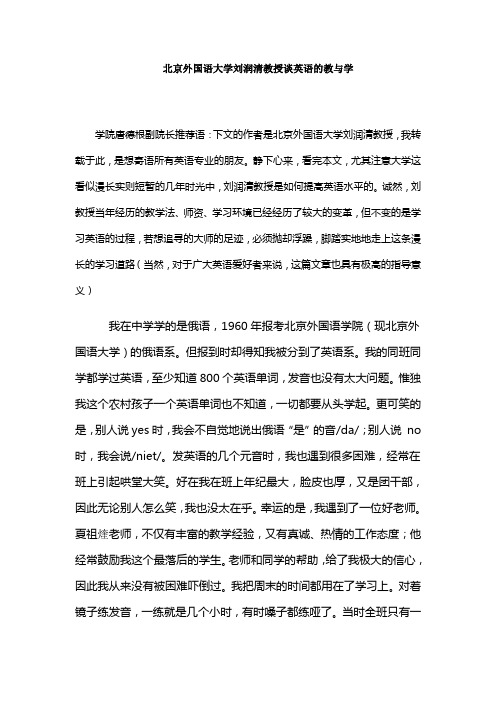
北京外国语大学刘润清教授谈英语的教与学学院唐德根副院长推荐语:下文的作者是北京外国语大学刘润清教授,我转载于此,是想寄语所有英语专业的朋友。
静下心来,看完本文,尤其注意大学这看似漫长实则短暂的几年时光中,刘润清教授是如何提高英语水平的。
诚然,刘教授当年经历的教学法、师资、学习环境已经经历了较大的变革,但不变的是学习英语的过程,若想追寻的大师的足迹,必须抛却浮躁,脚踏实地地走上这条漫长的学习道路(当然,对于广大英语爱好者来说,这篇文章也具有极高的指导意义)我在中学学的是俄语,1960年报考北京外国语学院(现北京外国语大学)的俄语系。
但报到时却得知我被分到了英语系。
我的同班同学都学过英语,至少知道800个英语单词,发音也没有太大问题。
惟独我这个农村孩子一个英语单词也不知道,一切都要从头学起。
更可笑的是,别人说yes时,我会不自觉地说出俄语‚是‛的音/da/;别人说 no 时,我会说/niet/。
发英语的几个元音时,我也遇到很多困难,经常在班上引起哄堂大笑。
好在我在班上年纪最大,脸皮也厚,又是团干部,因此无论别人怎么笑,我也没太在乎。
幸运的是,我遇到了一位好老师。
夏祖煃老师,不仅有丰富的教学经验,又有真诚、热情的工作态度;他经常鼓励我这个最落后的学生。
老师和同学的帮助,给了我极大的信心,因此我从来没有被困难吓倒过。
我把周末的时间都用在了学习上。
对着镜子练发音,一练就是几个小时,有时嗓子都练哑了。
当时全班只有一个大型录音机,要听大家都听,不听谁也别听,录音机死沉死沉的,也不可能搬到宿舍去。
录音里只有精读课文和生词,除此之外,就再也没有任何其他听力材料了。
我还经常在黑板上练拼写,写满一黑板,就擦掉又写。
单单这发音和拼法,就不知道花去了我多少时间。
我的语法还算好,当时没有什么专门的语法课,精读课文中出现什么语法现象,老师就顺便讲一下。
但总的来说,在第一学年,我一直是班上的最后一名。
到一年级结束的时候,我才算入了门。
刘润清外语教学中的科研方法

What has not been done?
What am I going to do? What are my findings? Implications and limitations
4、为什么要有文献综述?
使研究者综观全局,跟上形势 明确研究方向 吸收他人教训 把自己的研究置于一个恰当的学 术背景 文献综述并不容易做好
刘润清外语教学中的科研方法外语科研刘润清外语教学
外语教学中的科研方法
刘润清 中国外语教育研究中心
1、什么是科研?
用国际上公认的程序寻求两
个或两个以上的变量之间的 关系。
何为变量? 何为主变量? 何为因变量?
2、目前外语教学科研中的问题
多是主观印象型,经验总结型,
事后诸葛亮 缺少适当的学术研究背景,与其 它研究者搭不上话 科研的方法欠标准(工具不准、 抽样不够、统计方法欠妥等) 行文不规范 缺少参考书目
测量认知方式的镶嵌图形测试 测量智力的Raven初级智力测试和
Raven高级智力测试
7、关于测量工具 (tools / measurements)
测量语言学能的Modern Language
Aptitude Test
测量人格的16PF (Personality Features) 自己设计的工具要经过多次修改、预测、 再修改等,保证可靠性。如调查问卷的 设计就十分讲究。
11、参考书目:
Butler, C. 1985. Statistics in Linguistics. Basil Blackwell. 刘润清,1999,《外语教学中的科 研方法》。外研社。 刘润清,2004,《英语教育研 究》。外研社。
[精品]外语教学科研方法创新探索
![[精品]外语教学科研方法创新探索](https://img.taocdn.com/s3/m/937fec5c02768e9951e738a4.png)
中由于某些设计或实施中的缺陷而影响到研究 质量的例子,对我们特别有用,这就是所谓 “前车之鉴”。
3 理论框架 (1)对研究工作的理论框架作概述; (2)对所涉及的主要术语作解释。 4 研究方法 要具体写出(文科也要有),如:文献法,比较
法,女权主义批评法,心理分析批评法,等等。 比如实证研究,须写明实验、定性定量、调查工 具、调查对象、抽样方法、数据处理(人工处理 还是计算机处理)。
第二,明确研究方向
要进行创造性的研究,必须了解前人的工作,
不可照搬,避免重复。
前人的工作是我们的出发点,我们的研究是前
人研究的继续和延伸,不同时代的研究项目, 就像运动场上的接力赛一样。
前人的研究给我们做了铺垫,也指明了方向。
第三,吸取他人教训,避免同类错误 有关文献上常常记录着研究者的酸甜苦辣,其
0.文献综述有几项重要的作用不可忽视。
第一,它让研究者纵览全局,跟上形势。 只有广泛收集和阅读相关的研究, 才能对这个
领域有整体的把握和深刻的了解,才能知道目 前研究到何等地步。
有了这种整体把握,才能保证选定的课题是这
个领域的组成部分;也只有在这个大的背景下, 才能显示出自己课题的重要意义。
定性式的研究 是对一个或几个具体的个体进 行深入的调查,了解其一切情况,然后全面
分析,得出结论
例如:
调查解放前农村的情况,可以找一个典型的村
庄,对其贫下中农的代代遭遇进行详细了解, 把他们对旧社会的控诉成段成段地记录下来, 又把地主恶霸的罪行也详详细细地记录下采, 最后写成调查报告,如电影(白毛女)就像是定 性式的调查报告。内容详细、具体、贴近当事 人、充满感情、易于感人。虽然不能说每个农 村都完全像杨各庄,但贫农受的苦之大、仇之 深,可以与杨白劳家相比;地主老财们的罪恶 可以与黄世仁家相比。但是,这种个案研究的 缺点就是难从中概括其他情况,而且容易带上 调查人的个人感情与偏见。
语言学 刘润清
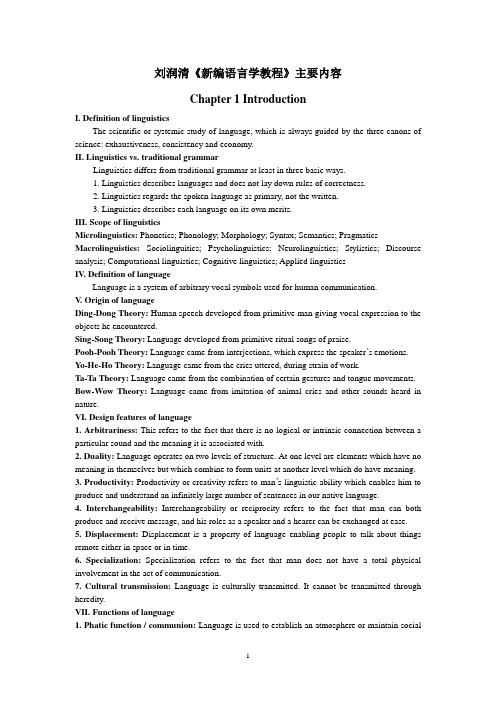
刘润清《新编语言学教程》主要内容Chapter 1 IntroductionI. Definition of linguisticsThe scientific or systemic study of language, which is always guided by the three canons of science: exhaustiveness, consistency and economy.II. Linguistics vs. traditional grammarLinguistics differs from traditional grammar at least in three basic ways.1. Linguistics describes languages and does not lay down rules of correctness.2. Linguistics regards the spoken language as primary, not the written.3. Linguistics describes each language on its own merits.III. Scope of linguisticsMicrolinguistics: Phonetics; Phonology; Morphology; Syntax; Semantics; Pragmatics Macrolinguistics:Sociolinguitics; Psycholinguistics; Neurolinguistics; Stylistics; Discourse analysis; Computational linguistics; Cognitive linguistics; Applied linguisticsIV. Definition of languageLanguage is a system of arbitrary vocal symbols used for human communication.V. Origin of languageDing-Dong Theory: Human speech developed from primitive man giving vocal expression to the objects he encountered.Sing-Song Theory: Language developed from primitive ritual songs of praise.Pooh-Pooh Theory: Language came from interjections, which express the speaker’s emotions. Yo-He-Ho Theory: Language came from the cries uttered, during strain of work.Ta-Ta Theory: Language came from the combination of certain gestures and tongue movements. Bow-Wow Theory:Language came from imitation of animal cries and other sounds heard in nature.VI. Design features of language1. Arbitrariness: This refers to the fact that there is no logical or intrinsic connection between a particular sound and the meaning it is associated with.2. Duality: Language operates on two levels of structure. At one level are elements which have no meaning in themselves but which combine to form units at another level which do have meaning.3. Productivity: Productivity or creativity refers to man’s linguistic ability which enables him to produce and understand an infinitely large number of sentences in our native language.4. Interchangeability:Interchangeability or reciprocity refers to the fact that man can both produce and receive message, and his roles as a speaker and a hearer can be exchanged at ease.5. Displacement: Displacement is a property of language enabling people to talk about things remote either in space or in time.6. Specialization: Specialization refers to the fact that man does not have a total physical involvement in the act of communication.7. Cultural transmission:Language is culturally transmitted. It cannot be transmitted through heredity.VII. Functions of language1. Phatic function / communion: Language is used to establish an atmosphere or maintain socialcontact between the speaker and the hearer. Greetings, farewells and comments on the weather serve this function.2. Directive function:Language is used to get the hearer to do something. Most imperative sentences are of this function.3. Informative function: Language is used to tell something, to give information, or to reason things out. Declarative sentences serve this function.4. Interrogative: Language is used to ask for information from others. All questions expecting replies serve this function.5. Expressive function:Language is used to reveal the speaker’s attitudes and feelings. Ejaculations serve this function.6. Evocative function:Language is used to create certain feelings in the hearers. Jokes, advertising, and propaganda serve this function.7. Performative function:Language is used to do things or to perform acts. The judge’s imprisonment sentences, the president’s declaration of war or the Queen’s naming of a ship, etc., serve this function.VIII. Some major concepts in linguistics1. Descriptive and prescriptive grammar(1) Descriptive grammars attempt to tell what is in the language; while prescriptive grammars tell people what should be in the language.(2) As traditional grammars tried to lay down rules, they are often called prescriptive. Most modern linguistics is descriptive.2. Synchronic and diachronic linguisticsWhen we study language at one particular time, it is called synchronic linguistics. When we study language developments through time, it is called diachronic or historical linguistics. Synchronic linguistics focuses on the state of language at any point in history while diachronic linguistics focuses on the differences in two or more than two states of language over decades or centuries.3. Lange and paroleF. de Saussure made an important distinction between langue and parole: Langue refers to the abstract linguistic system shared by all the members of a speech community. Parole refer to particular realization s of langue. Langue is the social, conventional side of language, while parole is individualized speech.4. Competence and performanceAccording to Chomsky, competence refers to the knowledge that native speakers have their language as a system of abstract formal relations, while performance refers to their actual linguistic behavior, that is, the actual use of this knowledge.5. Syntagmatic and paradigmatic relationsSaussure has put forward another pair of concepts: syntagmatic and paradigmatic relations. The former refers to the horizontal relationship between linguistic elements, which form linear sequences. The later means the vertical relationship between forms, which might occupy the same particular place in a structure.6. Functionalism and formalismFunctionalism or functional linguistics refers to the study of the forms of language in reference to their social function in communication.Formalism or formal linguistics is the study of the abstract forms of language and their internal relations.Chapter 2 Sounds in languageI. Phonetics1. Phonetics:The study of the speech sounds that occur in all human languages is called phonetics.2. Three major research fields of PhoneticsArticulatory phonetics: It is the study of how speech sounds are produced, or articulated. Acoustic phonetics: It deals with the transmission of speech sounds through the air.Auditory phonetics: It deals with how speech sounds are perceived by the listener.II. Articulators1. Seven major articulators:pharynx, velum or soft palate, hard palate, alveolar ridge or alveolum, tongue, teeth and lips2. Voiced and voiceless soundsWhen the vocal cords are spread apart, the airstream from the lung is not obstructed at the space between vocal cords and passes freely. The sounds produced in this way are described as voiceless sounds.When the vocal cords are drawn together, the airstream forces its way through and causes them to vibrate. Sounds produced in this way are described as voiced sounds.3. Nasal and oral soundsWhen the velum is lowered, air escapes through the nose as well as the mouth; sounds produced this way are called nasal sounds.When the velum is raised all the way to touch the back of the throat, the passage through the nose is cut off, the air can escape only through the mouth. Sounds produced this way are called oral sounds.III. Classification of English speech sounds1. Consonants(1) Consonants: consonants are sounds produced by constricting or obstructing the vocal tract at some places to divert, impede or completely shut off the flow of air in the oral cavity.(2) Manner of articulation and place of articulationManner of articulation refers to the type of stricture involved in the production of a consonant (the particular way the airstream is obstructed).Place of articulation refers to the involvement of the articulators in the production of a particular consonant (where the airstream is most obstructed).(3) Classification of consonantsIn terms of manners of articulation, consonants can be grouped into stops, fricatives, affricated, liquids, nasals and glides.In terms of place of articulation, the consonants can be grouped into bilabials, labiodentals, dentals, alveolars, palatals, velars and glottal.2. Vowel(1) Vowels: vowels are sounds produced without obstruction, so no turbulence or a total stopping of the air can be perceived.(2) The height of the tongue: front vowel; central vowels; back vowels(3) The shape of the lips: rounded vowels; unrounded vowels(4) The width of the mouth: open vowels; close vowels; semi-open vowels(5) Monophthongs and diphthongsMonophthongs: They are those pure vowels that have an unchanging quality, either from the number or the con stant quality.Diphthongs: A sequence of two sounds produced from one vowel position to anther.IV. Variations of sounds1. Liaison: The phenomenon of the linking of two words in speech, in particular when the second word begins with a vowel, is called liaison.2. Elision: The loss of a sound or sounds in speech is called elision.3. Assimilation: The way that sounds belonging to one word or one syllable can cause change in sounds belonging to neighboring words or syllables is called assimilation.V. Phonology1. Phonology:phonology is the description of the systems and patterns of speech sounds in a language.2. Phoneme:phoneme is a basic unit of phonological study, and it is an abstract collection of phonetic features which can distinguish meaning.3. Minimal pairs and setsMinimal pairs are pairs of words which differ from each other only by one sound.When a group of words can be differentiated each one from the others, by changing one phoneme (always in the same position), then we have a minimal set.4. Free variation: When two or more sounds occur in the same position without any apparent change of meaning, they are said to be in free variation.5. Distinctive features: When a feature distinguishes one phoneme from another it is a distinctive feature (or a phonemic feature).VI. Syllables and consonant cluster1. Syllables: The English word beautiful consists of three speech units: beau-ti-ful. These units, which are often longer than one sound and smaller than a whole word, are called syllables. Syllable structure:syllableonset rime (rhyme)nucleus (peak) codaconsonant(s) vowel consonant(s)2. Consonant cluster: In English some words may contain a sequence of two or more consonants in one syllable, for example, /spl/ in /′splendid/. Sequences of consonants like this are called consonant clusters.VII. Suprasegementals1. Suprasegmental features: The sound contrasts that extend over several segments (phonemes), are called suprasegmentals.2. Stress: When a word has more than one syllable, one of them will be pronounced with more prominence than others. This brings us to the speech sounds phenomenon, that of stress.3. Intonation: Speech sounds which are identical as to their place or manner features may differ in length, pitch or loudness. When speaking, people generally raise and lower the pitch of their voice. This phenomenon is called intonation.Chapter 3 MorphologyI. Morphology: morphology, as a branch of linguistics, is the study of the internal structure, forms and classes of words.II. MorphemeMorpheme: morpheme is the smallest unit of language, a unit that cannot be divided into further smaller units without destroying or drastically altering the meaning, whether it is lexical or grammatical.2. Types of morphemes(1) Free morphemeFree morphemes are those which may occur alone or constitute words by themselves. All monomorphemes are free morphemes and polymorphemic words, which consist wholly of free morphemes, are compounds.A word must contain an element that can stand by itself, that is, a free morpheme, such as talk. Such an element is called a root. A word may contain more than one root.When they are used with bound morphemes, the basic word-form involved is technically as the stem.Free morphemes can be divided into two categories. The first one is the set of message we convey. These free morphemes are called lexical morphemes and, since we can create new lexical morphemes for the language rather easily, they are called an open class of words.The second category of free morphemes is called functional morphemes. As we almost never add new functional morphemes to the language, they are called a closed class of words.(2) Bound morphemesSome morphemes cannot normally stand alone, but function only as parts of words, e.g. –s, -er, -ed and –ing. Such morphemes are called bound morphemes.Bound morphemes are actually affixes. All affixes in English are bound. Affixes can be joined to the beginning of the root or stem, in which case they are called prefixes. Prefixes can change the meaning or function of the word.Affixes can also be joined to the end of the root or stem, in which case they are called suffixes. Suffixes can also change the meaning or function of the word.Bound morphemes can be classified into two categories. One category is derivational morphemes, which are used to make new words in the language and are often used to make words of a different grammatical category from the stem.The other category is inflectional morphemes, which are not used to produce new words, but rather to show aspects of the grammatical function of a word.III. Morphs and allomorphMorphs are the smallest meaningful phonetic segments of an utterance on the level of parole.An allomorph is a set of morphs which represent the same morpheme. Allomorphs are phonological or orthographic variants of the same morpheme.IV. Types of word formation1. Compounding:By means of compounding, two free morphemes are combined to form acompound. Compounds have strict patterns. The first element in the compound receives the main stress, but it is generally the second element that determines the compound’s new word class.2. Derivation: Derivation is done by adding affixes to other words or morphemes. In contrast to compounding, a derivational word consists of at least a free morpheme and a bound morpheme.3. Other ways of word formation(1) Conversion: Many words have more than one part of speech. A noun can become a verb easily and a verb can be used as a noun. Such instances are called conversion. Conversion is also called zero derivation.(2) Backformation: There are times when we remove a suffix to get a new word. For example, as we have editor, we get edit by dropping or. This process is called backformation.(3) Clipping: The process by which parts of a word have been cut off is called clipping. Clipping occurs when a word of more than one syllable is reduced to a shorter form, often in casual speech.(4) Blending: A single new word can also be formed by combing two separate forms. This process is usually called blending. Typically, blending is finished by taking only the beginning of one word and joining it to the end of another word.(5) Acronym: Some new words are formed from the first letters of a series of words. They are pronounced as a single word.(6) Initialism: Some new words are composed of the first letters of a series of words and pronounced by saying each letter in them. These kinds of words are called initialisms.Chapter 4 SyntaxI. Syntax1. Syntax: Syntax is the study of the rules governing the ways different constituents are combined to form sentences in a language, or the study of the interrelationships between elements in sentence structures.2. Word classesThe general word classes include: nouns; adjectives; verbs; adverbs; prepositions; pronouns and conjunctions.II. Two approaches1. The prescriptive approach: It is an approach taken by some grammarians, mainly in eighteenth century England, which views grammar as a set of rules for the “proper”use of a language, and it is still to be found today and may be best characterized as the prescriptive approach.2. The descriptive approach:Throughout the 20th century, linguists collect samples of the language they are interested in and attempt to describe the regular structures of the language as it is used, not according to some view of how it should be used. This is called the descriptive approach and it is the basis of most modern attempts to characterize the structure of different languages.III. Structural analysisIts main objective is to study the distribution of linguistic forms in a language. The method involves the use of “test-frames” which can be sentences with empty slots in them. By developing a set of test-frames of this type and discovering what forms fit the slots in the test-frames, we can produce a description of some aspects of the sentence structures of a language.1. The constituent structure grammarA grammar which analyzes sentences using only the idea of constituency, which reveals a hierarchy of structural levels, is referred to as a constituent structure grammar.2. Immediate constituent analysis (IC analysis)(1) Definition: The immediate constituent analysis may be defined as the analysis of a sentence in terms of its immediate constituents ——word groups (or phrases), which are in turn analyzed into the immediate constituents of their own, and the process goes on until the ultimate constituents are reached. However, for the sake of convenience, in practice we usually stop at the level of word. The immediate constituent analysis of a sentence may be carried out with brackets or with a tree diagram.(2) Advantages: Through IC analysis, the internal structure of a sentence may be demonstrated clearly, and ambiguities, if any, will be revealed.(3) Problems:①At the beginning, some advocators insisted on binary divisions. Any construction, at any level, will be cut into two parts. But this is not always possible.②Constructions with discontinuous constituents will pose technical problems for tree diagrams in IC analysis. The most serious problem is that there are structural ambiguities which cannot be revealed by IC analysis.IV. The transformational grammar1. Chomsky’s classical theoryIn the earliest version of transformational grammar sometimes now called the “classical theory”—Chomsky put forward a model which consisted of three parts: a set of phrase structure rules, transformation rules and morphophonemic rules.(1) The phrase structure rules were based on constituent structure analysis but formalized as a set of rules. Chomsky emphasized the generative aspect of such rules although any constituent structure grammar is generative by definition, that is, it can produce many sentences.(2) Chomsky then introduced the idea of a set of transformation rules which could transform these simple “kernel” sentences S NP + VP into a number of related sentences.(3) The morphophonemic rules would apply to the output of the transformational rules. Their function was to provide the correct morphological shape to the various parts of the structure and finally to give the appropriate phonological description.2. The standard theory(1) Deep structure and surface structureThe deep structure is the abstract representation of the syntactic properties of a construction, i.e. the underlying level of structural relations between its different constituents.The surface structure is the final stage in the syntactic derivation of a construction, which closely corresponds to the structural organization of a construction people actually produce and receive.(2) The standard theoryDeep structure to SemanticsTransformational componentSurface structure to PhonologyV. Systemic-Functional grammar1. General accountThe characteristics of the theory are systemic and functional. It characterized Halliday’s theory as more attention is paid to paradigmatic relations than to syntagmatic relations. And this is the main concern of Chomsky. What is new in Halliday is that he has tried to relate the functions of language to its structures. He argues that there are three general functions of language: ideational, interpersonal and textual. And they are related to three grammatical systems: transitivity, mood and theme.2. Three general functions of language(1) The function that in which we conceptualize the world for our own benefit and that of others is called ideational function.(2) Language serves to set up and maintain social and personal relations, including communication roles such as questioner and respondent, and to express the language user’s own attitudes and comments on the content of an utterance. This function of language is called interpersonal function.(3) Language also makes links with itself and with features of the situation in which it is used. This is what enables the speaker or writer to construct a text, and enables the listener or reader to distinguish a text from a random set of sentences. This function of language is called textual function.Chapter 5 SemanticsI. Semantics: Semantics is a branch of linguistics which is concerned with the study of meaning in all its formal aspects.II. Some approaches to the study of meaning1. Meaning as naming(1) Referential theory or naming theoryThe meaning of an expression is what it refers to, or names, is often called referential theory or naming theory.(2) ProblemsOne of them is that it is not always immediately obvious what is being named.2. Meaning as conceptAny particular sound image is psychologically associated with a particular concept. Semantic triangleconcept………………………..symbol referent“Symbol” is the linguistic element, i.e. word, sentence, etc. and the “referent” is the object in the world of experience, while “concept” is human thought.3. Meaning as behaviorBloomfield argued that meaning exists in the relation between speech and the practical events that precede and follow it. The meaning of a linguistic form is thus defined as observable behaviors. Such an approach to meaning is called behaviorism, or behaviorist theory, which clearly draws on psychology.4. Meaning as contextThe view that meaning is found in the context within which a particular expression is uttered suggests that we can derive meaning from, or reduce it to, the observable context. Such an approach to meaning clearly draws on sociology.5. Meaning as truth conditionsKnowing the meaning of a sentence is the same as knowing the conditions under which the sentence is true or false. And knowing the meaning of a word or expression is knowing the part that it plays in the truth or falsehood of the sentence containing it. Such an approach to meaning is called truth-conditional theory / semantics, which clearly draws on formal logic.III. Word meaning1. Sense and reference(1) Sense is to be defined in terms of relationships which hold between the linguistic elements themselves (mostly words), it is concerned with intralinguistic relations.(2) Reference or extension deals with the relationship between linguistic elements (words, sentences, etc.) and the non-linguistic world of experience, e.g. things, actions, events and qualities.2. Seven types of meaningAccording to the British linguist G. Leech, meaning in its broadest sense can be classified into seven types: conceptual, connotative, social, affective, reflective, collocative and thematic meanings. Among them, connotative, social, affective, reflective and collocative meanings are called associative meaning.(1) Conceptual meaning also called denotative or cognitive meaning, is the essential and inextricable part of what language is, and is widely regarded as the central factor in verbal communication. Conceptual meaning can be studied in terms of contrastive features or a binary feature formal.(2) Connotative meaning is the communicative value that a word or a combination of words ahs by virtue of what it refers to, over and above its purely conceptual content.(3) Social meaning is the meaning which an expression conveys about the contexts or social circumstances of its use.(4) Affective meaning conveys the language user’s feelings, including his attitude or evaluation in shaping his use of language.(5) Reflective meaning is the meaning which arises in cases of multiple conceptual meanings, when one sense of a word forms part of our response to anther sense.(6) Collocative meaning: The associations a word gets because of the meanings of words which tend to occur in its linguistic context are called collocative meanings.(7) Thematic meaning: It refers to the meaning arises out of the way in which the writer or speaker organizes his message.3. Semantic fields(1) Definition: It is the organization of related words and expression into a system which shows their relationship to one another.(2) Lexical gap: The absence of a word in a particular place in a semantic field of a language is called lexical gap.4. Componential analysisAll lexical items can be analyzed into a set of semantic features or semantic components which may be universal. This semantic theory is called Componential Analysis (CA).5. Major sense relations(1) Homonymy: In any language there are words which have the same linguistic form but are different in meaning.(2) Polysemy: When a word has two or more meanings that are related conceptually or historically, it is said to be polysemous or polysemic. Words of this kind are called polysemic or polysemous words.(3) Homophony:Words which sound alike but are written differently and often have different meanings are called homophones. Homophones are a type of homonymy, so they are sometimes called homonyms.(4) Synonymy: There are not only words that sound the same but have different meanings; there are also words that sound different but have the same meaning. Such words are called synonyms, and the sense relation of “sameness of meaning” is called synonymy.(5) Antonymy:Words that are opposite in meaning are often called antonyms. The oppositeness of meaning is called antonymy.(6) Hyponymy: It is the sense relation between terms in a hierarchy, where a more particular term (the hyponym) is included in the more general one (the superordinate): X is a Y.(7) Metonymy: It is the sense relation between terms which is the part of the other word and also called part / whole relationship. Metonymy can be expressed by the pattern “X is a part of Y.”IV. Sentence meaning1. Sentence and propositionThe semantic content shared by different expressions is a proposition. Generally speaking, one can find out whether the proposition is true or false.As for the relationship between sentences and proposition, different sentences convey the same message——they express the same proposition.2. Semantic roles(1) Definition: It is the way in which the referent of a noun phrase is involved in the situation described or represented by the clause.(2) Classification:Agent & patientExperiencerInstrumentCauseRecipientBenefactiveLocativeTemporal3. Semantic relationships between sentences(1) Entailment: Entailment is a type of meaning-dependence between one sentence and another. In terms of truth value, the following relationships exist between the two sentences if a entails b: When a is true, b is necessarily true; when b is false, a is false; when b is true, a may be true or false.(2) presuppositionIn terms of truth value, the following relationships exist between two sentences: When a is true, b is necessarily true; when a is false, b is till true; when b is true, a can either be true or false; when b is false, no truth value can be said about a.(3) SynonymyTwo sentences may have the same meaning, that is, in terms of truth value, a has the same truth vale as b: If a is true, b is true; also if a is false, b is false; and vice versa.(4) Inconsistency or contradictionA is inconsistent with b: if a is true, b is false; also, if b is true, a is false.(5) ImplicatureImplicature is also a type of semantic relation between two sentences. If we can draw conclusion b from sentence a, here b is the implicature of a.Chapter 6 PragmaticsI. Pragmatics1. Definition: Pragmatics is the study of speakers’intended meaning, or even the “invisible”meaning, that is, how hearers recognize what is meant even when it isn’t actually said or written.2. Difference between pragmatics analysis and grammatical analysisFirst, grammatical studies look for rules while pragmatic studies look for principles.Second, in grammar studies, we end up with products while in pragmatics we always deal with progress.3. Definition of micropragmatics and macropragmatics(1)To study the meaning of the pieces of language in smaller contexts is called micropragmatics. Phenomena such as reference, deixis, anaphora and presupposition, are the topics in this field.(2) To study on the larger chunks of language, and look deep into the mechanisms. This approach of study is called macropragmatics.II. Micropragmatics1. ReferenceAn inference is any additional information used by the hearer to connect what is said to what must be meant.In pragmatics, the act by which a speaker or writer uses language to enable a hearer or reader to identify something is called reference.。
外语教学毕业论文参考文献
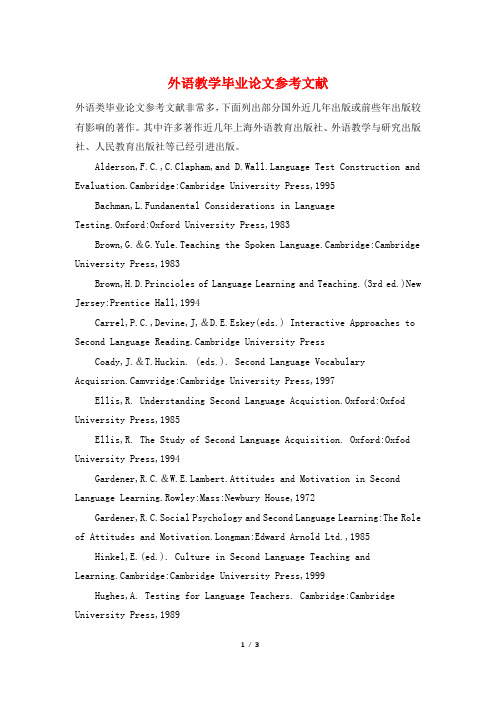
外语教学毕业论文参考文献外语类毕业论文参考文献非常多,下面列出部分国外近几年出版或前些年出版较有影响的著作。
其中许多著作近几年上海外语教育出版社、外语教学与研究出版社、人民教育出版社等已经引进出版。
Alderson,F.C.,C.Clapham,and nguage Test Construction and Evaluation.Cambridge:Cambridge University Press,1995Bachman,L.Fundanental Considerations in LanguageTesting.Oxford:Oxford University Press,1983Brown,G.&G.Yule.Teaching the Spoken Language.Cambridge:Cambridge University Press,1983Brown,H.D.Princioles of Language Learning and Teaching.(3rd ed.)New Jersey:Prentice Hall,1994Carrel,P.C.,Devine,J,&D.E.Eskey(eds.) Interactive Approaches to Second Language Reading.Cambridge University PressCoady,J.&T.Huckin. (eds.). Second Language Vocabulary Acquisrion.Camvridge:Cambridge University Press,1997Ellis,R. Understanding Second Language Acquistion.Oxford:Oxfod University Press,1985Ellis,R. The Study of Second Language Acquisition. Oxford:Oxfod University Press,1994Gardener,R.C.&mbert.Attitudes and Motivation in Second Language Learning.Rowley:Mass:Newbury House,1972Gardener,R.C.Social Psychology and Second Language Learning:The Role of Attitudes and Motivation.Longman:Edward Arnold Ltd.,1985Hinkel,E.(ed.). Culture in Second Language Teaching and Learning.Cambridge:Cambridge University Press,1999Hughes,A. Testing for Language Teachers. Cambridge:Cambridge University Press,1989James,C. Errors in Language Learning and Use. New York:Longman,1998 Johnson,K.E. Understanding Communicative Language Classrooms. Cambridge:Cambridge University Press,1995Krashen,S. Principles and Pracrice in Second LanguageAcquisition.Oxford:Pergamon,1982Lynch,B.K. Language Program Evaluation. Cambridge:Cambridge University Press,1996Nunan,D. The Learner-Centred Curriculum. Cambridge:Cambridge University Press,1988Nunan,D. Designing Tasks for the Communicative Classroom. Cambridge:Cambridge University Press,1989O’Malley,J.M&A.U.Chamot. Learning Strategies in Second Language Acquisition. Cambridge:Cambridge University Press,1990Odlin,T. Language Transfer. Cambridge:Cambridge UniversityPress,1989Richard,J. Approaches and Methods in Language Teaching. Cambridge:Cambridge University Press,1986Richards,J.C.&C.Lockhart.Reflective Teaching in Second Language Classrooms. Cambridge:Cambridge University Press,1996Seliger,H.W.&Shohamy,E. Second Language ResearchMethods.Oxford:Oxford University Press,1989Stern,H.H. Fundamental Concepts of Language Teaching. Oxford:Oxford University Press,1983Ur,P. Teaching Listening Comprehension. Cambridge:Cambridge University Press,1984Ur,P. A Course inLanguage Teaching. Cambridge:Cambridge University Press,2001Wallace,M.J. Action Research for Language Teachers.Cambridge:Cambridge University Press,1998Widdowson,H.G. Teaching Language as Communication. Oxford:Oxford University Press刘润清外语教学的科研方法北京:北京外语教学与研究出版社,1999。
刘润清《新编语言学教程》Syntax教学课件

Lexical categories 词汇范畴
The name given to classes into which lexical items are grouped. --There are traditionally 8 classes: Noun, Pronoun, Verb, Adjective…. --Modern linguistic theories have more, ranging from 12-140+! -- They are also known as parts of speech and word classes
--Semantic criteria, structural ambiguity “Flying planes can be dangerous”
·if you live under the flight path. · if you haven’t got a pilot’s license.
--Notional criteria
The definition of syntax
A subfield of linguistics that studies the sentence structure of language. Specifically, it studies the combination
of words to form sentences and the rules that govern the formation of sentences.
2. It clearly demonstrates that sentences are not mere left-to-right linear sequences of elements. Instead, elements come into relationships of great complexity and varying kinds.
语言学家:刘润清人物简介

02
刘润清教授具有创新精神
• 敢于挑战传统观念和权威理论
• 为语言学领域的发展提供了新的思路和方法
03
刘润清教授具有高度的责任感
• 对待学术成果和教育事业总是认真负责
• 为语言学领域的发展做出了重要贡献
刘润清的教书育人理念及实践
刘润清教授提出了以学生为中心的教学理念
• 注重培养学生的自主学习能力和创新能力
路和方法
重要贡献
研究成果在语
言教学实践中
也得到了广泛
应用
刘润清在语言学研究中的创新方法
刘润清教授在语言学研究方法方面有所创新
• 引入了实验心理学和神经语言学的研究方法
• 为语言学研究提供了新的视角和手段
刘润清教授在研究数据收集和分析方面进行了有益探索
• 采用实验法和观察法收集数据
• 利用统计软件进行数据分析
刘润清教授在研究成果转化方面取得了显著成果
• 将研究成果应用于语言教学实践
• 为提高语言教学质量做出了重要贡献
03
刘润清的职业生涯及贡献
刘润清的职业生涯发展
刘润清教授在学术界具有很高的声誉
• 担任多个学术兼职
• 主持过多个国家级科研项目
刘润清教授在教育领域也取得了显著成果
• 提出了以学生为中心的教学理念
DOCS SMART CREATE
语言学家刘润清人物简介
CREATE TOGETHER
DOCS
01
刘润清的学术背景及成就
刘润清的学历及留学经历
刘润清教授在国际学术界具有广泛的影响力
• 参加过多次国际学术会议并发表演讲
• 与多个国际学术机构保持合作关系
选择研究方法的方法
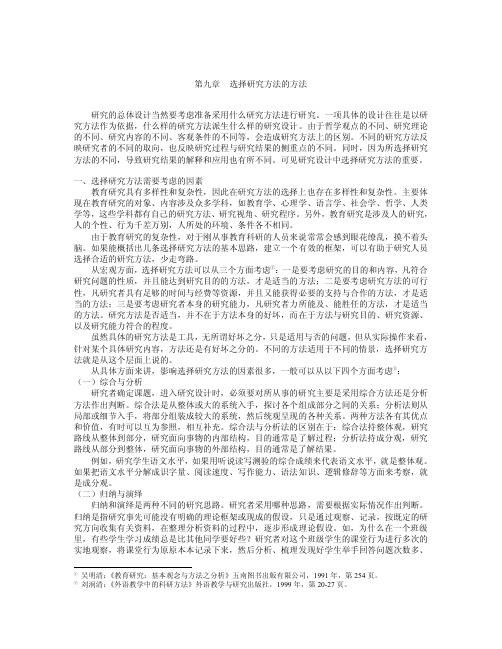
第九章选择研究方法的方法研究的总体设计当然要考虑准备采用什么研究方法进行研究。
一项具体的设计往往是以研究方法作为依据,什么样的研究方法派生什么样的研究设计。
由于哲学观点的不同、研究理论的不同、研究内容的不同、客观条件的不同等,会造成研究方法上的区别。
不同的研究方法反映研究者的不同的取向,也反映研究过程与研究结果的侧重点的不同。
同时,因为所选择研究方法的不同,导致研究结果的解释和应用也有所不同。
可见研究设计中选择研究方法的重要。
一、选择研究方法需要考虑的因素教育研究具有多样性和复杂性,因此在研究方法的选择上也存在多样性和复杂性。
主要体现在教育研究的对象、内容涉及众多学科,如教育学、心理学、语言学、社会学、哲学、人类学等,这些学科都有自己的研究方法、研究视角、研究程序。
另外,教育研究是涉及人的研究,人的个性、行为千差万别,人所处的环境、条件各不相同。
由于教育研究的复杂性,对于刚从事教育科研的人员来说常常会感到眼花缭乱,摸不着头脑。
如果能概括出几条选择研究方法的基本思路,建立一个有效的框架,可以有助于研究人员选择合适的研究方法,少走弯路。
从宏观方面,选择研究方法可以从三个方面考虑①:一是要考虑研究的目的和内容,凡符合研究问题的性质,并且能达到研究目的的方法,才是适当的方法;二是要考虑研究方法的可行性,凡研究者具有足够的时间与经费等资源,并且又能获得必要的支持与合作的方法,才是适当的方法;三是要考虑研究者本身的研究能力,凡研究者力所能及、能胜任的方法,才是适当的方法。
研究方法是否适当,并不在于方法本身的好坏,而在于方法与研究目的、研究资源、以及研究能力符合的程度。
虽然具体的研究方法是工具,无所谓好坏之分,只是适用与否的问题,但从实际操作来看,针对某个具体研究内容,方法还是有好坏之分的。
不同的方法适用于不同的情景,选择研究方法就是从这个层面上说的。
从具体方面来讲,影响选择研究方法的因素很多,一般可以从以下四个方面考虑②:(一)综合与分析研究者确定课题,进入研究设计时,必须要对所从事的研究主要是采用综合方法还是分析方法作出判断。
刘润清北京外国语大学2013西安

3. 如何教本科学生?
单元音 元音 双元音 前元音 [i:] [i] [e] [æ ] 中元音 [ʌ] [ə:] [ə] 后元音 [u:] [u] [ɔ:] [ɔ] [a:] 开合双元音 [ei] [ai] [ɔi] [əu] [au] 集中双元音 [iə] [εə] [uə]
爆破音 摩擦音
辅音 破擦音
3. 如何教本科学生?
物种独有:We live in and through language. To speak less metaphorically, much of the business of our lives is carried out through linguistic means. It is largely with words that we organize our activities and attempt to construct representations and models of the world. It is largely through words that we express ourselves,
3. 如何教本科学生?
如果“他昨天进城了”里的“他”是位刑警,听话 人是个罪犯,讲话人小声地讲“他昨天进城了”, 就成了警告:“你小心点。”如果大家在办公室七 嘴八舌地说是小李昨天把计算机搬回自己家去了, 有个人站起来说“他昨天进城了。”何义? 阿呆给处长送礼时的对话:“你这是什么意 思?”“没什么意思,意思意思。”“你这就不够 意思了。” “小意思,小意思。” “你这人真有意 思。” “其实也没有别的意思。”“那我就不好意 思了。” “是我不好意思。”
3. 如何教本科学生?
有多位哲学家说过,越是看不见的东西越是重要。 我们看不见光、热、电、能量、引力、氧气、意识; 但它们都是我们离不开的东西。语言是个抽象系统, 说它抽象,是因为它的许多词义不确定。像“我”、 “你”、“他”等人称代词,没有定指。正在说话 的人就是“我”;听别人说话的人是“你”;在不 在场的第三者是“他”。还有,“这”、“那”、 “今天”、“明天”等也没有定指,全看讲话人何 时何地在讲话。
